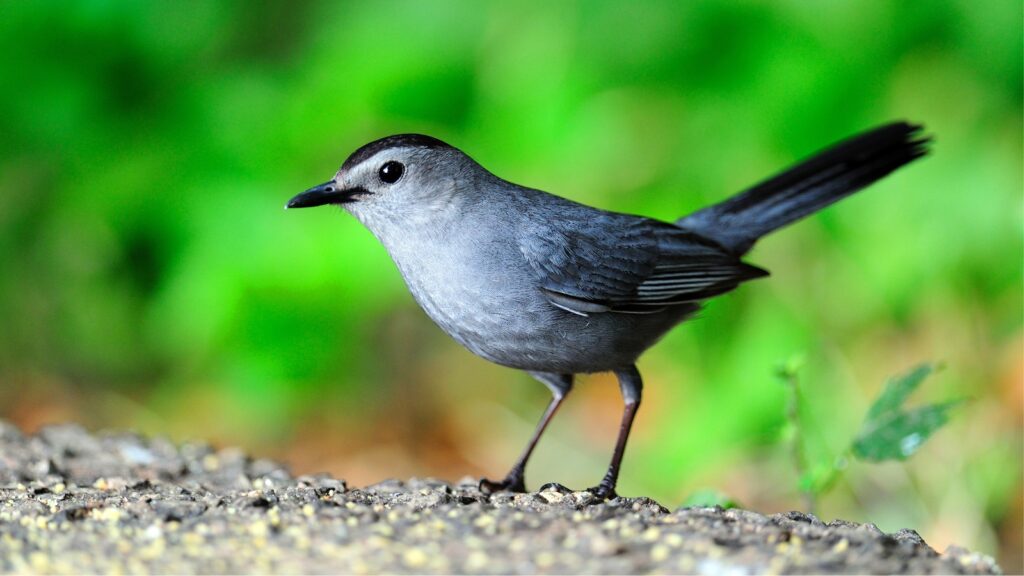The Diamond State is overflowing with protected valleys and rivers to preserve countless species. In other words, you’ll have the pick of the litter when it comes to spotting small birds in Delaware.
With roughly 7,000 acres of land protected by the state, several small bird species can thrive. Although you can’t visit all of their nature preserves, there are still quite a few open to the public.
I’ll help you identify and spot 15 small birds in Delaware with the list below. You’ll also get a few suggestions for birdwatching spots at the end so you can plan your next trip successfully.
Song Sparrow

- Species Name: Melospiza melodia
- Length: 11 cm to 18 cm
- Weight: 22 grams
- Wingspan: 18 cm to 25 cm
The song sparrow is a common sight throughout Delaware year-round.
Let’s start off the list with one of the easiest birds to spot (but not always the easiest to identify!). The song sparrow is an adorable little bird with a round body and speckled brown and white coloration.
Males and females look very similar, though males will be a little larger and heavier. Both birds have a short, pale beak and thick white streaks over their eyes that look like eyebrows.
Song sparrows earned their name for their bright and happy call, often composed of sweet chirps followed by a long trill. You’ll easily find them foraging along the ground in a variety of environments such as shrublands, marshlands, or suburban areas.
These birds usually eat insects and seeds, though you can attract them to your backyard with fresh berries or a well-tended birdbath.
White-Throated Sparrow

- Species Name: Zonotrichia albicollis
- Length: 15 cm to 19 cm
- Weight: 22 grams to 32 grams
- Wingspan: 23 cm
White-throated sparrows usually show up in Delaware during non-breeding season, though a few will linger year-round.
White-throated sparrows are one of the easier sparrow species to identify. While they have the classic brown body and white stomach, they have a unique yellow patch above their eyes.
They also have thick black streaks along their head and a white patch beneath their beak. Males and females look rather similar to each other – these birds are unique in that they sometimes boast a yellow patch, but sometimes don’t.
White-throated sparrows work hard to forage for berries, insects, and seeds. They love visiting feeders, so stock up on millet or black oil sunflower seeds.
American Goldfinch

- Species Name: Spinus tristis
- Length: 11 cm to 14 cm
- Weight: 19 cm to 22 cm
- Wingspan: 11 grams to 20 grams
If you’re a fan of musical birds, you’ll be glad to know the American goldfinch stays in Delaware year-round.
The American goldfinch is a beloved sight for birders and it’s small wonder why. Male American goldfinches have a sleek body shape, vivid yellow body, black and white striped wings, and a charming black ‘cap’.
Female American goldfinches are also lovely, boasting olive-green and yellow feathers with similar black and white wings. However, they have no black cap – it’s also worth noting males look similar to females outside of breeding season.
These charming little birds spend much of their time in meadows and shrubbery habitats for seeds. They’re a common sight at feeders and often like to bring their friends, so entice them to your backyard with sunflower seeds or nyjer.
House Finch
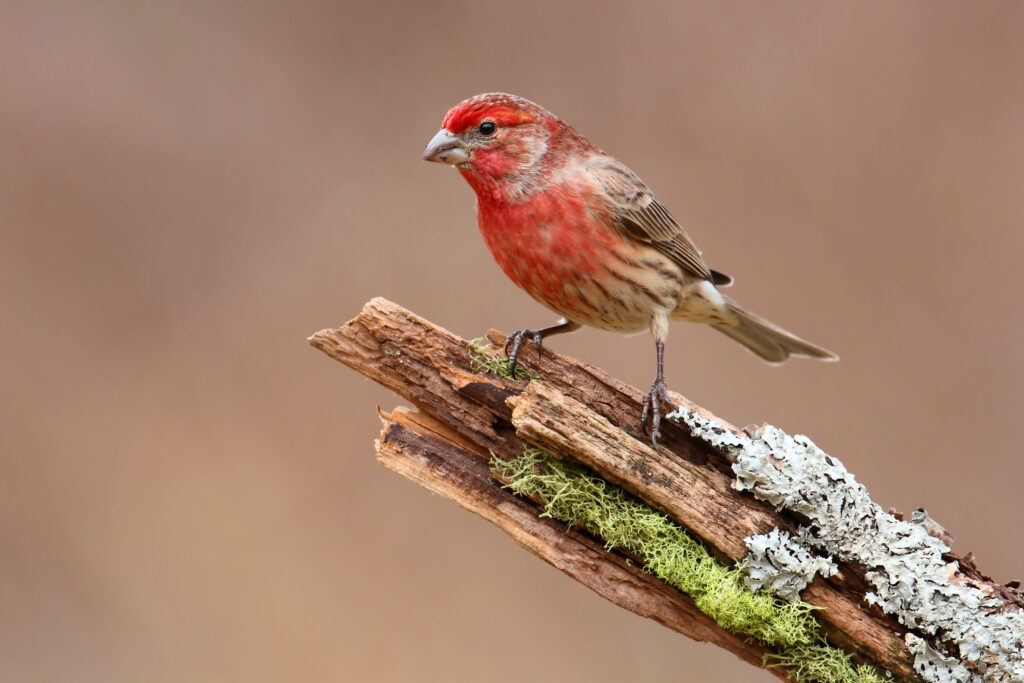
- Species Name: Haemorhous mexicanus
- Length: 12 cm to 15 cm
- Weight: 16 grams to 27 grams
- Wingspan: 20 cm to 25 cm
The house finch is a common species in Delaware and is seen year-round.
When a birder is asked about an adaptable bird species, the house finch is usually at the top of the list. Sometimes confused for sparrows, the male house finch has a gray-brown body with a distinctive red ‘flush’ along his face.
Female house finches are a light gray-brown with heavy streaking and no red coloration. Both species have the characteristic conical bill of their species.
A major contribution to house finches’ adaptability is their diverse diet, as they eat everything from insects to seeds to fruit. They’re comfortable in just about any environment and are a common sight in backyards, metros, forests, and fields.
They’re quick to visit bird feeders, particularly if you stock up on their favorites like nyjer or sunflower seeds. They’re quite territorial, however, so don’t be surprised if they scare away other birds!
Check out our guide on finches in Delaware to see what other species you can find (though some are quite rare!).
House Wren
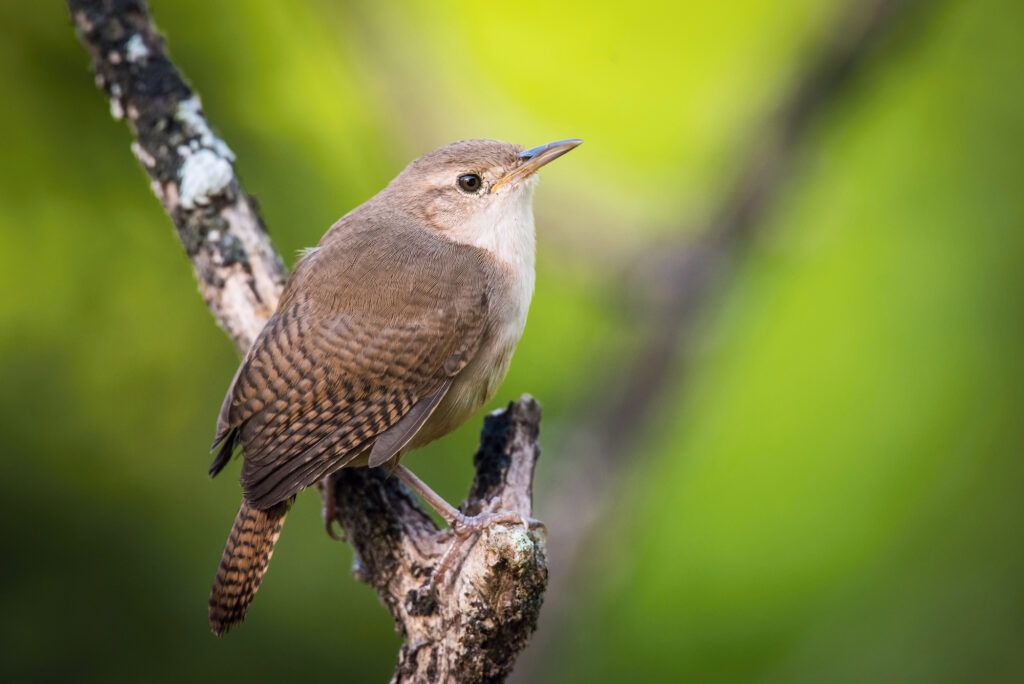
- Species Name: Troglodytes aedon
- Length: 11 cm to 13 cm
- Weight: 10 grams to 12 grams
- Wingspan: 15 cm
These tiny birds are very common in Delaware and appear throughout the state year-round.
If you’re a fan of complex birdsong, you’ll adore the house wren. These musical birds have a light gray-brown body, sleek shape, and needle-like beak.
Males and females look very similar. You’re more likely to hear a house wren before seeing one since they blend so easily into their environment.
House wrens boast a dynamic and bubbly song composed of chirps, trills, and twitters. They’re active foragers often scurrying along the ground for snails, beetles, and spiders.
Attract a house wren to your backyard with suet or with a nice, clean birdbath. They might also enjoy diving in and out of brush piles.
Tufted Titmouse

- Species Name: Baeolophus bicolor
- Length: 14 cm to 16 cm
- Weight: 17 grams to 26 grams
- Wingspan: 20 cm to 26 cm
This iconic songbird is common in Delaware and can be found year-round.
It’s small wonder why the tufted titmouse is a frequent subject of photography and paintings. These charming birds are light blue-gray with a white belly, brown sides, and a characteristic tufted head.
Males and females look quite similar, though males are larger and have a bigger black patch above their beak.
The tufted titmouse is a bold bird and can be found in several environments such as dense forests, spacious parks, and occasionally your backyard. Their birdcall varies, sometimes sounding like a rapid zit-zit-zit and other times like pee-wer pee-wer.
Their diverse diet involves berries, insects, fruit, and seeds. You can attract tufted titmice with a little suet or some sunflower seeds.
Indigo Bunting
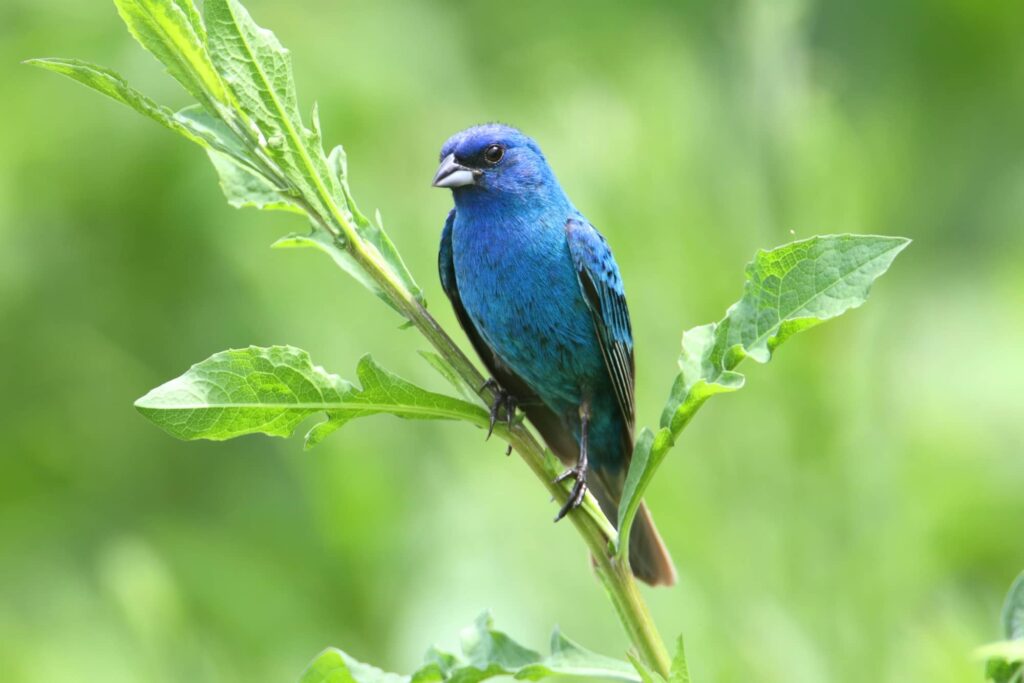
- Species Name: Passerina cyanea
- Length: 11 cm to 15 cm
- Weight: 14 grams
- Wingspan: 18 cm to 23 cm
The indigo bunting is sometimes glimpsed in Delaware during breeding season, though is rather rare.
Shining like a jewel in the sun, the indigo bunting is a striking sight for birders of all experience levels. The male indigo bunting is an intense blue with dark gray wings and a black eye mask.
The female indigo bunting is a soft gray-brown with hints of gray-blue along her wings and a pink beak.
Outdoor birders will have an advantage due to indigo buntings preferring to forage around woodland edges or near rivers. However, they’re more likely to visit backyard feeders during winter when food is scarce.
These stunning birds eat a steady diet of insects, berries, and seeds – they’re especially fond of caterpillars and grass seeds. Try attracting them to your feeder with mealworms.
Carolina Chickadee

- Species Name: Poecile carolinensis
- Length: 10 cm to 11 cm
- Weight: 4 grams to 8 grams
- Wingspan: 16 cm
These darling little birds are common throughout most of the state year-round but are scarce in the north.
The Carolina chickadee is a delight, both for its bold coloration and how easy it is to spot. Their light gray and white plumage pops against the foliage, topped only by their distinct black ‘cap’ and throat.
If you’re a fan of hiking on forest trails, expect to see plenty of Carolina chickadees – their preferred habitats are both mixed and deciduous forests. That said, they’re likely to visit feeders if they’re well-stocked and surrounded by trees.
How did this bird get their name, you ask? As it stands, they happen to make a call that sounds quite close to chicka-dee-dee-dee.
Carolina chickadees are dedicated insectivores, though they occasionally sample the occasional seed. Try attracting them with feeding stations stocked with suet or peanuts.
Eastern Towhee
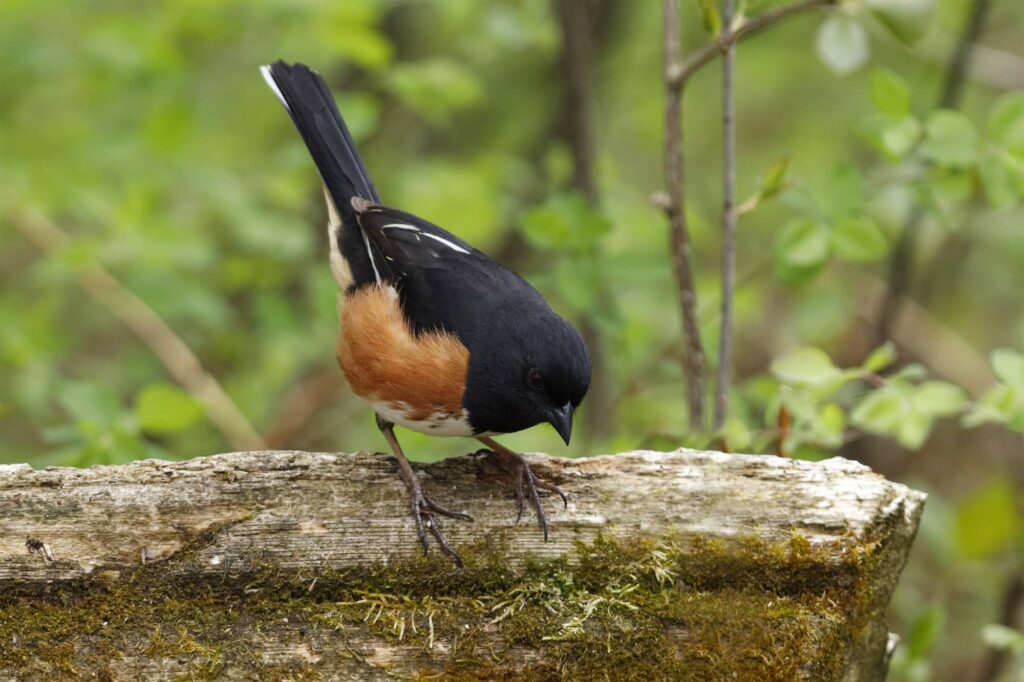
- Species Name: Pipilo erythrophthalmus
- Length: 17 cm to 20 cm
- Weight: 32 grams to 52 grams
- Wingspan: 20 cm to 28 cm
The Eastern towhee is a year-round resident in Delaware, but expect to see them more often during the warmer months.
The dashing Eastern towhee is a sight you can’t miss. Males have a vivid black head and chest with cinnamon-brown sides and a white stomach.
Females look similar to males, but differ in their bold, dark color — they’re patchier and of a faded, grayer coloration.
While Eastern towhees sometimes linger on forest edges, they’re commonly seen in prairies and marshes. Since Delaware is a haven of salt marshes and swamps, you won’t have to travel far to find them.
These birds have an incredibly diverse diet, eating a mixture of fruits, seeds, snakes, lizards, and frogs. You can attract them to your backyard with classics like millet or sunflower seeds.
Eastern Bluebird

- Species Name: Sialia sialis
- Length: 16 cm to 21 cm
- Weight: 27 grams to 34 grams
- Wingspan: 25 cm to 32 cm
The Eastern bluebird is a lovely sight in Delaware and shows up all over the state year-round, though they’re more common during the summer.
It’s always a good day when you see one of these little beauties perched on a windowsill. The male Eastern bluebird is a bright sky blue with a cinnamon-brown chest and lower white underparts.
The female Eastern bluebird looks similar to the males but is more patchy and faded — almost gray coloring. I always thought they looked a little frosted.
These gorgeous birds love to frequent meadows and fields, often perching on fences or wires so they can survey their environment. They love insects such as grasshoppers and beetles, though they’ll also eat the occasional snail.
Want to do a little backyard birding in Delaware? Try attracting them with mealworms (but place your feeder in a spacious area).
Dark-Eyed Junco

- Species Name: Junco hyemalis
- Length: 14 cm to 16 cm
- Weight: 18 grams to 30 grams
- Wingspan: 18 cm to 25 cm
Dark-eyed juncos have an interesting pattern in Delaware. They usually show up during winter, but may periodically appear during late summer and early fall.
The dark-eyed junco is a small bird with a big personality. These squat sparrows have a dusky gray body with a lighter stomach, bright pink beak, and permanent frown.
These compact birds have several sub-species such as the gray-headed dark-eyed junco and the red-backed dark-eyed junco.
You can most easily find dark-eyed juncos around heavily forested areas, though they sometimes dabble along forest edges. They prefer to eat seeds, but will occasionally switch to insects when they’re low on their usual food supply.
If you want to attract a few to your backyard, stock up on black oil sunflower seeds and millets. These birds are ground foragers, so you can easily attract them by just sprinkling feed on the ground.
Downy Woodpecker

- Species Name: Dryobates pubescens
- Length: 14 cm to 18 cm
- Weight: 20 grams to 33 grams
- Wingspan: 25 cm to 31 cm
This distinctive bird is a year-round resident in Delaware and is pretty common.
You won’t have to search far to find the downy woodpecker pecking away. The male downy woodpecker has a black body and black wings coated in white streaks – he’s best known for the cherry red spot on the side of his head.
Female downy woodpeckers look very similar but with no red spot.
These birds are most comfortable in forested areas where they can drill into trees. They usually eat insects – especially beetles, ants, and their larvae – but will switch to seeds and berries occasionally.
You can easily attract these dynamic birds to your feeder with suet cakes or sunflower seeds. They’ll even sip sugar water if you keep any hummingbird feeders nearby.
Northern Cardinal

- Species Name: Cardinalis cardinalis
- Length: 21 cm to 23 cm
- Weight: 42 grams to 48 grams
- Wingspan: 25 cm to 31 cm
The Northern cardinal is incredibly common in Delaware and is a year-round resident.
What a sight! The male Northern cardinal never fails to impress with his tomato red plumage, red beak, black face mask, long tail, and tufted head.
The female Northern cardinal is just as lovely with her pinkish-gray feathers, reddish wings, red beak, and long tuft.
The Northern cardinal is quite beloved for its clear and crisp birdsong. They sometimes let out wheet-wheet-wheet patterns or let out chirps that almost sound like a human whistling.
These birds generally eat a mixture of grains and seeds. You’ll spot them easily in dense environments such as wetlands, forests, and lush gardens.
If you have a platform or hopper feeder, stock up on millet and peanuts. They love an easy meal.
Red-Winged Blackbird

- Species Name: Agelaius phoeniceus
- Length: 17 cm to 24 cm
- Weight: 29 grams to 82 grams
- Wingspan: 31 cm to 40 cm
Get your summer checklists ready. This bold bird is a year-round resident in Delaware, but you’ll see far more during the spring and summer months.
You’ll quickly see how the red-winged blackbird got its name. The male has a jet-black body with a brilliant red and yellow spot along his wings.
Female red-winged blackbirds look like a different species entirely. While they have a similar pointed beak and rounded tail, they have dark brown feathers with a striped head.
This bird is quite adaptable, but often prefers open spaces (and is frequently found perching somewhere high to survey the environment). Expect to find them in marshlands, prairies, fields, meadows, and fields.
Red-winged blackbirds seem to eat everything – their diet includes snails, frogs, seeds, worms, spiders, plant matter, and even mollusks.
These social birds are a delight for bird watchers who like to watch the dynamics of flocks. You may be able to attract them to your feeder by scattering seeds onto the ground.
Gray Catbird
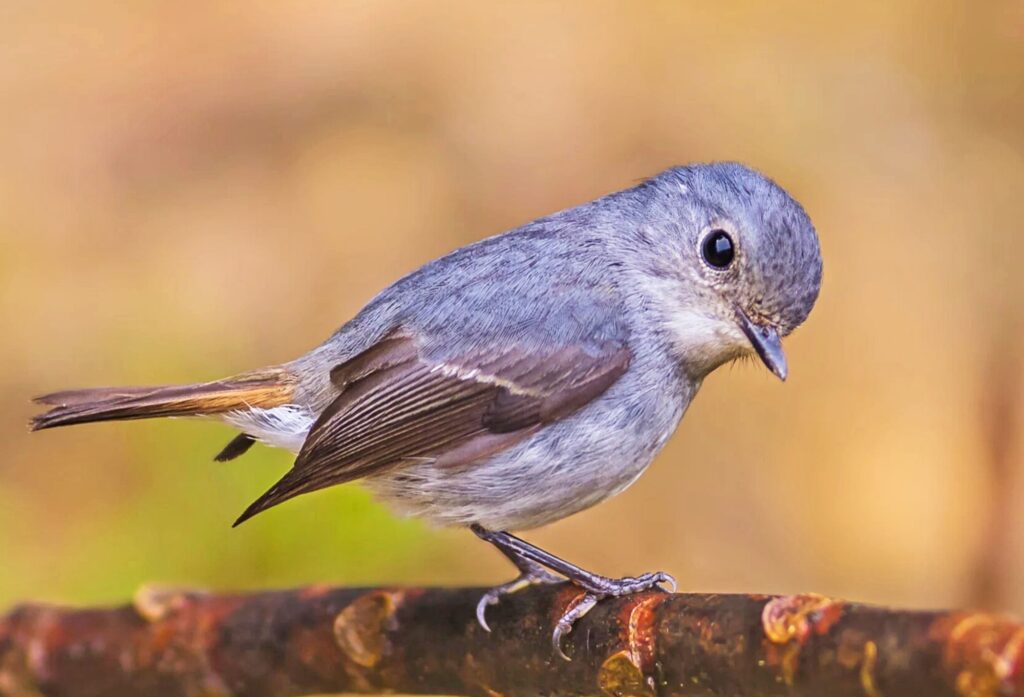
- Species Name: Dumetella carolinensis
- Length: 20 cm to 24 cm
- Weight: 23 grams to 56 grams
- Wingspan: 22 cm to 30 cm
Last but not least, the gray catbird is a frequent sight during breeding season in Delaware, but scarce the rest of the year.
The gray catbird is distinctive for both its appearance and its call. Gray catbirds have a dusty light gray body with a darker patch on their head, dark tail feathers, and a dainty black beak.
Males and females look very similar, so you’ll have to pay close attention to their behavior to tell which is which. Males are often louder in their song and will show off their rump feathers during mating displays.
These birds earned their name for their unique call – they sound just like a housecat. Even more interesting, they can produce up to 100 different sounds.
Gray catbirds eat a mixture of insects and berries, preferring to forage in shrubby fields or along forest edges. However, you can attract them to your feeder if you plant a lot of shrubs or fill your feeder with fresh fruit.
Delaware Has Plenty of Opportunities for Easygoing Birding
A major point in Delaware’s favor is how easy it is to spot these bird species. Most of the birds on this list are just a backyard birding session or a quick hike away.
If you could use a few starting points, consider visiting the Bombay Hook National Wildlife Refuge to spot some wrens or the Woodland Beach Wildlife Area for sparrow species.
Curious to see what other species are in Delaware? Check out the lists below:

